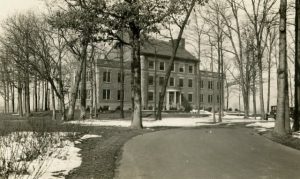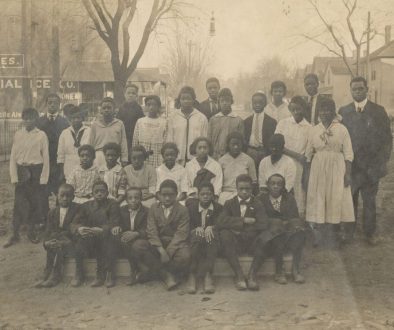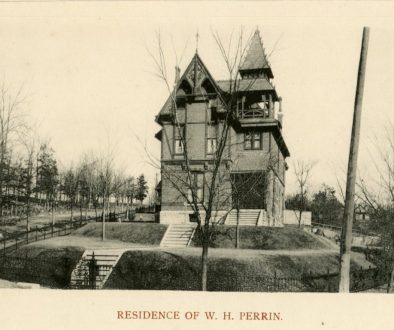Tuberculosis: The White Plague by William Dichtl
Originally published in the TCHA newsletter, Weatenonte, Vol. 25, No. 5, May 1992.
The disease “consumption” later called tuberculosis (TB) killed more Americans in the 19th century than any other disease. Efforts to fight tuberculosis were complicated by the lack of a known cause, until March 24, 1882. At that time, Dr. Robert Koch discovered that thousands of germs rode upon a speck of dust. These particles of dust carried TB from one person to another.
An estimated 153,800 Americans died from TB in 1900. This waste of life could no longer be tolerated, and the National Tuberculosis Association was founded in 1904 to help eradicate the “white plague.” The goal of the Association was to have TB under control by 1933.
The war on tuberculosis in Tippecanoe County began in 1904 with the formation of the Lafayette Society for the Prevention of Tuberculosis. A local salesman, Charles W. Ebel, spearheaded the beginning of the society. He became involved because his sister had died from TB. Charles was chosen the first corresponding secretary and Purdue Professor Severance Burrage served as the first president.
To raise money to build a tuberculosis pavilion in Delaware, Emily P. Bissell organized the sale of the first Christmas seals in the United States in 1907. This idea was based on the success the people of Denmark had in 1904 for raising money for children with TB.
Miss Bissell convinced the American Red Cross to undertake the project in 1908. Two years later the National Tuberculosis Association joined forces with the Red Cross in the sale of Christmas seals. The partnership lasted ten years, at which time the Red Cross decided to concentrate on its annual Roll Call to raise money.
One of the goals of the Lafayette Society was to build a sanatorium with money raised from the seal sales. The money received from sales never amounted to enough to begin the project. Instead, money went to establishing a TB camp or for erecting TB shacks.

Besides the Christmas seals sale, the Lafayette Society organized Lafayette’s first public health campaign in July 1922, with a health week. Other groups participating included Purdue University, the Women’s Council, the Flower Mission, the Tippecanoe Medical Society, and both the State and County Boards of Health. There were exhibits, lectures, and handouts about tuberculosis and other diseases.
The year 1921 proved to be significant in the local fight against TB. The Lafayette Society for the Prevention of Tuberculosis reorganized as the Tippecanoe County Tuberculosis Association (TCTA) and found a permanent home on Sixth Street in a room in the new Painters and Decorator’s Building (later home of the Lafayette Journal & Courier). The new organization brought health expert Murray P. Horwood from the Massachusetts Institute of Technology to conduct a health survey of Tippecanoe County.
The health survey was the first to be conducted in the state of Indiana and one of the first in the nation. Mr. Horwood spent the summer compiling information throughout the county. Some of the results were alarming, but nothing that could not be rectified if acted on immediately. One problem involved public drinking fountains like the artesian well on the courthouse square. This fountain and others like it were breeding grounds for TB and other diseases because the water came straight up and fell back over the bubbler. This meant the backwash with germs fell over the bubbler and into fresh water to pass along to the next person. Mr. Horwood recommended that these bubblers be replaced with those that sprayed water at an angle.
The milk supply was also a cause of TB. The dairy cows carried Bovine Tuberculosis that was passed on to humans through the milk. Unsanitary conditions and a lack of testing for TB resulted in spreading of the “white plague.” Local dairies immediately took to cleaning up this problem. Pasteurizing milk came in to use and this dramatically improved the situation, preventing contamination.
On March 28, 1921, Dr. Charles J. Eatfield, the National Tuberculosis Association’s director, said, “…no cure for TB has been discovered.” Seventeen days later Dr. H.E. Robertson, professor of pathology at the University of Minnesota, stated that 50% of all Americans at some time in their lives have had TB. Of the remaining 50%, half have been menaced at some time by TB. He also stated, “…we may not be able to keep the germs of tuberculosis from entering the body … but we can prevent their development into disease.”
Both Dr. Eatfield and Dr. Robertson believed the best way to combat the “white plague” was with plenty of fresh air, wholesome nutritious food, hard work, eight hours of sleep per day, cleanliness, periodic physical exams, and muscle building exercises.
At this time a new trend in dealing with tuberculosis was developing. Doctors and tuberculosis associations believed preventing TB would be better than curing.
With this in mind, TCTA began offering free clinics every month, beginning June 1922. The purpose was to diagnose the early stages of TB. In July, TCTA began the first fresh air camp, held at Rotary Park. For three weeks each summer, TCTA selected a group of girls and a group of boys who were under the age of thirteen, underweight, and prime candidates for TB. They were sent to camp to receive nourishing food, sunlight, and fresh air, and to participate in exercises and receive instruction in health habits.
Like so many things in life, there is a lot of misinformation out there. Tuberculosis has its old wives’ tales, too. It was believe that if you had TB you should go west to a better climate such as Arizona to Colorado. One well-known person who had TB and took this advice was Doc Holliday, a dentist and gunfighter who joined forces with Wyatt Earp to fight the Clantons in Tombstone, Arizona at the OK Corral.
Dr. Rockhill of Cincinnati stated at an Indiana Tuberculosis Association meeting in 1922 that TB patients do not recuperate in a better climate. In fact, more natives of Arizona died of TB than Indiana natives.
Pioneers who moved to Indiana had remedies to cure the “white plague.” One remedy called for boiling devil’s tongue leaves in water and drinking the resulting beverage. Another suggested spreading horse manure liberally all around the outside of the house where you live, and you will soon get well. Still another said to take a cupful of finely powdered hops and put it in a quart of good rye whiskey. Take two tablespoons full in the morning, one at noon and one in the evening, and two before going to bed. None of the above remedies cure TB.
Health and insurance reports of August 28, 1922, indicated that cancer was the number one killer in the United States, surpassing tuberculosis. This happened not because cancer had increased, but rather there had been a decline in TB cases. In 1921, 107,100 people died in the United States from TB. This was down 14,000 from the previous year.
In recent years Tippecanoe County has had heated debates over the public library, the outdoor drama and the state park. Seventy years ago another heated debate took place over the county building a tuberculosis hospital. Two sides were drawn and both wrote letters to the editor expressing their opinions. The anti-TB hospital group was not against helping the afflicted, but rather they were concerned about the increase in taxes. On November 8, 1922, the final vote showed the hospital had been voted down two to one.
The TCTA did not stop attempting to have a hospital because of the vote. In 1927 they discussed building their own sanatorium. But they did not have the finances to do so. Two years later the County Commissioners discussed purchasing the Wabash Valley Institute for the tuberculosis sanatorium. The TCTA was against the idea because they wanted a new facility to be built to fit established standards.
In 1929, Mr. and Mrs. David Linn Ross donated $140,000 to have a tuberculosis hospital built. The William Ross Sanatorium was named for David Ross’ brother, who had died from TB. The sanatorium, operated by the County, closed in the early 1960’s because the number of people with TB had dropped drastically. In 1960 there were 55,494 cases of the “white plague,” and 10,866 people died from TB in the United States. Today Ivy Tech on Route 52 uses the building as part of its campus.

A disease that in the early 1900s was hoped to be controlled by the 1930’s is still with us. According to the August 19, 1991 issue of American Hospital Association News, “Tuberculosis, which has been targeted for elimination by 2010, is approaching epidemic levels in major U.S. cities, according to the Centers for Disease Control, Atlanta. The agency said incidence of the disease, which reached a nine-year high of 25, 601 last year, is rising because of susceptibility to tuberculosis among drug addicts, the homeless, and people infected with the AIDS virus.”
The fight against the “white plague” still is being wage and is being carried on by others.
*Note: The Tippecanoe County Historical Association is home to the Tippecanoe County Tuberculosis Association archival collection which documents the groups activities from 1908 to 1984.





